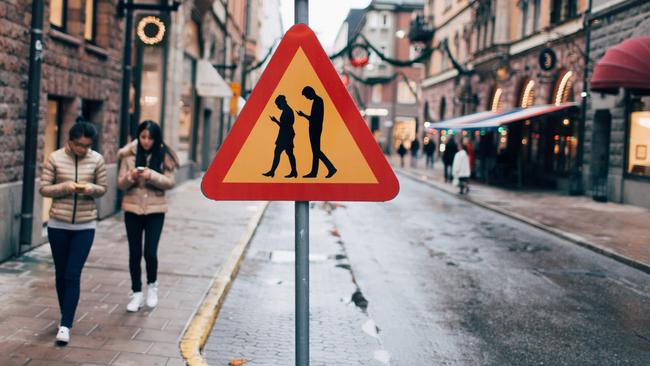Smombies - zombies on smartphones - are walking into accidents
A person walks down the street sending texts and watching Youtube videos. You won’t believe what happens next.
Manny Fiori’s job is to make sure your phone doesn’t kill you. He guards the entrance to a garage in San Francisco and stops cars from hitting pedestrians who are so engrossed in screens they don’t notice they’re stepping into traffic.
“People are so oblivious nowadays,” says Fiori, who barks orders and even holds out his arms to stop cars and people.
Watching the morning rush with Fiori is a scary measure of our smartphone addiction. In one hour we tallied 70 pedestrians who never looked up — some watching TV shows, many writing emails. Five can thank him for preventing them from colliding with cars.
I’m hardly innocent. My phone bears scars that look like I got in a fight with a bobcat — actually, I walked into a wall while texting.
It was sort of a joke when the distracted-pedestrian phenomenon first arrived, YouTube is filled with footage of texters falling into fountains. The Germans have a word for such people: smombie — smartphone plus zombie.
But when garages have to hire guards to save us from ourselves, texting while walking is no longer a joke. It’s a public safety conundrum. At the very least, it’s a design failure in devices that have mastered how but not when to get our attention.
I crunched data from the US Consumer Product Safety Commission and discovered that emergency room visits involving distracted pedestrians using mobile phones were up 124 per cent in 2014 from 2010 — and up 10-fold from 2006. The increase was consistent with an analysis by Jack Nasar, a professor of city and regional planning at Ohio State University, who found a big uptick in cases from 2005 to 2010.
Some researchers blame gadgets for 10 per cent of pedestrian injuries in the US. And while distracted driving causes more severe accidents, incidents involving texting walkers are more common.
I asked a colleague to dress up like Chewbacca from Star Wars and hang out on a San Francisco street during the morning commute. Then I interrupted pedestrians staring down at their phones and asked whether they’d noticed a Wookiee lurking. Many hadn’t.
Ira Hyman Jr, a psychology professor at Western Washington University, tells me this is called “inattentional blindness”. In 2008, he conducted one of the first versions of my phone-distraction test, asking passers-by if they’d noticed a clown on a unicycle. Half of the non-mobile-using pedestrians saw the clown, but only a quarter of people talking on a phone did.
Even the strong-willed are susceptible to a buzzing gadget, perfectly crafted to reward our brains’ desire to find new things and be social. Just see how long you can ignore an incoming text.
I’m not holding my breath that many people will keep their mobile phones stashed when they hit the sidewalk. But we need to teach children that putting down their phones when crossing the street is up there with looking both ways.
Better urban planning could help. Some towns and campuses have put “look up” signs in dangerous stairwells and intersections. Announcements in Hong Kong’s subways advise passengers: “Don’t keep your eyes only on your mobile phone.” New York City reduced speeds for cars, and San Francisco has made more busy corridors pedestrian-only, partly in response to smombies.

Last year, road signs appeared in Stockholm warning cars about texting pedestrians. It turns out the signs were made by artists Jacob Sempler and Emil Tiismann. It was a social-media sensation. “Which is pretty ironic,” says Sempler.
How much of an obligation do the phone makers have to address this growing danger? The auto industry is a useful comparison: many lives were saved when people chose to wear seatbelts, but still more were saved when airbags became mandatory.
Smartwatches such as the Apple Watch and Samsung’s Galaxy Gear keep data addicts from having to look down at their phone all the time, replacing it with a smaller screen that’s faster to check. And the Ditto, a tiny $40 wireless device I’ve been trying, vibrates when your phone has a notification you actually care about.
The core problem is the phone itself. Rutgers University engineer Shubham Jain has been working with colleagues on an app that determines when someone using a phone is walking into an intersection. When you do, it momentarily locks the phone screen and flashes a warning to look up. I tried one version, which taps the phone’s GPS to determine what’s an intersection. Another version uses inexpensive sensors in shoes to determine, within two steps, when the user has stepped into the street.
“There is no cure for stupidity,” says Jain. But the same technology that created the problem could also play a role in its solution, she says, by suppressing distractions and alerting us to dangers. Nobody wants a digital nag, but maybe if this were a slick Apple Watch feature, some of us might turn it on.


